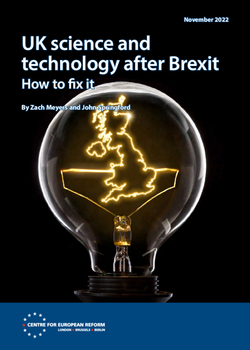
UK science and technology after Brexit: How to fix it
- Uncertainty about the UK’s participation in Horizon Europe, the EU’s €95.5 billion research and innovation fund, has been one of the biggest issues in the fractious post-Brexit UK-EU relationship. The EU will not allow Britain to join the programme before the Northern Ireland Protocol is settled.
- Horizon has been an important source of funding for academic scientists in Britain. The loss of Horizon would damage British science and make it harder for UK universities to recruit the best staff from the EU. The British government could give scientists more funding to help replace Horizon grants, and British scientists could still be involved in some Horizon projects even if the UK is not a member. But the loss of Horizon membership would make UK science funding less certain over the long term and reduce collaboration between UK and EU scientists. The British government could not replicate many of the advantages of Horizon Europe, such as its economies of scale and the prestige that winning its grants provides. Universities will face challenges in trying to replace lost partnerships with EU-based institutions.
- Brexit is hindering the supply of skilled labour and investment, which have bigger effects than Horizon on the development of technology and its diffusion across the economy. For many years, British universities have produced world-class scientific research, while Britain’s corporate sector has struggled to convert those breakthroughs into new, innovative products. Brexit makes it harder for the UK to tackle these problems.
- Brexit has limited the UK’s access to skilled European workers in the science, technology, engineering, and medicine (STEM) fields. While the government’s efforts to liberalise the immigration system have sought to mitigate this problem, our analysis suggests that this has only partially made up for the end of EU free movement.
- Brexit has also caused problems for investment in sectors of the economy that employ a lot of workers with STEM degrees. After the vote to leave the EU, business investment in these sectors stagnated, and then dropped significantly during the pandemic and the exit from the single market.
- Rejoining the EU single market would resolve many of these problems. Since that is unlikely for many years, the government could adopt a range of other policies to improve UK science and technology after Brexit. These policies include:
- settling the Northern Ireland Protocol, which would unlock membership of Horizon and lift the threat of a trade war
- setting out an evidence-based plan for assessing when the UK should diverge from EU standards
- bringing Britain’s political parties together to agree to an enduring pact on science and innovation funding and to stop tinkering with the institutions that govern it
- reducing the many disincentives that still exist for highly skilled workers to take up jobs in the UK.
Brexit has certainly not helped UK science and technology and in some ways has damaged it. The UK’s participation in Horizon Europe, the EU’s research and innovation fund, remains uncertain. Lord Frost, Britain’s lead negotiator of the UK-EU Trade and Co-operation Agreement (TCA), had pressed for Britain to be an associate member of Horizon, in a rare effort to remain part of an EU programme.
After then prime minister Boris Johnson’s attempt to renegotiate the Northern Ireland Protocol, the EU decided to postpone Britain’s participation in order to give itself leverage. It had previously done the same thing to Switzerland, after the latter’s referendum that sought to limit freedom of movement in 2014, and more recently as a result of disputes about Swiss payments to the EU budget and the governance of the Swiss-EU bilateral agreements. While scientists have deplored the harm the EU-UK dispute is causing to both sides, it appears that the EU will not let the UK join Horizon until the Protocol issue is settled. As a result, important scientific collaborations are clouded in uncertainty – and as this uncertainty goes on, scientists are increasingly making alternative plans for their research.
Yet the UK faces broader problems with how scientific knowledge and technology are developed, commercialised and used. While exclusion from Horizon is a problem, because it has been an important source of funding for academic scientists in Britain, the UK has strengths in basic research, and continues to outperform many EU countries. More important to economic prosperity than academic funding, however, is the diffusion of technology across the economy. Brexit has had – and will continue to have – a profound impact on that. For example, the end of free movement has cut the number of skilled European data scientists and engineers taking jobs in the UK. The government has tried to make it easier for skilled workers from around the world to migrate to Britain, but our analysis shows that this has only partially made up for the end of free movement. Similarly, investment flatlined after the referendum, and then fell during the pandemic, lagging behind other European countries since 2016. The result has been a slower rate of adoption of new technology and of improvements in the computers and machinery used in British firms.
The UK’s weaknesses in commercialising and deploying new technologies have contributed to the UK’s consistently poor productivity. Addressing this question is even more urgent after Brexit, because higher trade barriers with the EU have been contributing to weakening productivity growth.
This policy brief sets out the challenges facing UK academics working in science, technology, engineering and medicine (STEM) fields as a result of Brexit. It enumerates the problems UK universities are facing in recruiting staff from the EU – and examines whether they are managing to recruit more academics from the rest of the world. It then discusses the impact that Brexit has had on the flows of European workers into sectors of the economy that employ the most STEM graduates, and whether the new immigration regime, which came into operation under the Johnson government, is liberal enough to offset the loss of free movement. Then it considers investment, and whether high-STEM sectors have struggled after the vote to leave the EU. We conclude with a discussion of the policies that the government can pursue to improve UK science and technology after Brexit, both in academia and in the wider economy.
How the Horizon dispute is affecting UK academic science
The EU’s €95.5 billion Horizon Europe research programme runs from 2021-2027 as part of the seven-year EU budget cycle. Horizon Europe and its predecessor programmes, such as Horizon 2020, have been a part of the EU budget since 1984 and will undoubtedly be continued after 2027.
When the UK and EU concluded the TCA, both intended that the UK would continue to participate in most of the EU’s research and innovation programmes. The TCA set out the broad financial terms for the UK’s associate membership in the Horizon Europe programme. However, the terms of membership were not concluded in the TCA, and were instead left to be agreed later, by a joint ‘Specialised Committee on Participation in Union Programmes’.
The Committee has met only once, on December 21st 2021, and it has still not finalised the terms of the UK’s participation in Horizon. In mid-August 2022, under Johnson, the UK initiated dispute resolution proceedings under the TCA, claiming that “UK membership of Horizon Europe would be a win-win for both the UK and EU”.1 After she became prime minister, there were signs that Liz Truss was prepared to compromise on the Northern Ireland issue, thereby unlocking UK participation in Horizon. However, it remains to be seen whether the UK’s new prime minister, Rishi Sunak, will have the will and ability to follow through.
This section explains the consequences of the UK staying out of Horizon. First, it examines the impact that Brexit has had on the ability of UK universities to recruit STEM researchers from EU member-states. It then examines the financial and research impacts of being excluded from Horizon membership.
The impact of Brexit on the recruitment of EU academic scientists
If the Horizon standoff is not resolved, as we explain below, the UK will suffer from a loss of collaboration with scientists based in the EU and the loss of EU academics working in Britain.
How many UK-based scientists are from the EU should, in theory, make little difference to the quality of UK science. The labour market for academic scientists has become global, especially for leading universities. The rapid growth in science funding for UK institutions – which has risen from £2 billion to £6 billion since 2000 – and highly competitive systems for distributing that funding, have meant that top institutions command large research budgets.2 British universities recruit the best doctoral students, post-doctoral researchers and faculty they can from around the world.
Even though the inflow of scientists from the rest of the world offset some of the collapse in EU researchers moving to the UK, it is reasonable to think Brexit has reduced the quality of science in Britain.
Chart 1 shows that British universities employed more new scientists from EU countries than from the UK or the rest of the world in most years between 2004 to 2016. Then the inflow of EU scientists fell to nearly zero in 2019/20 and 2020/21. In a 2018 poll conducted by the Crick Institute in London, a leading biomedical research centre, half of the institute’s research group leaders said that Brexit was already affecting their ability to recruit scientists.3 However, the growth in the number of scientists from the UK and rest of the world accelerated after 2016 (although it stalled during the pandemic). This suggests that, as EU scientists were put off by risks to EU research funding, uncertainty about collaborations with their home institutions, diminished career prospects, higher tuition fees for doctoral students who staff labs, or simple frustration about Brexit, British universities filled roles by hiring people from the UK and outside the EU.
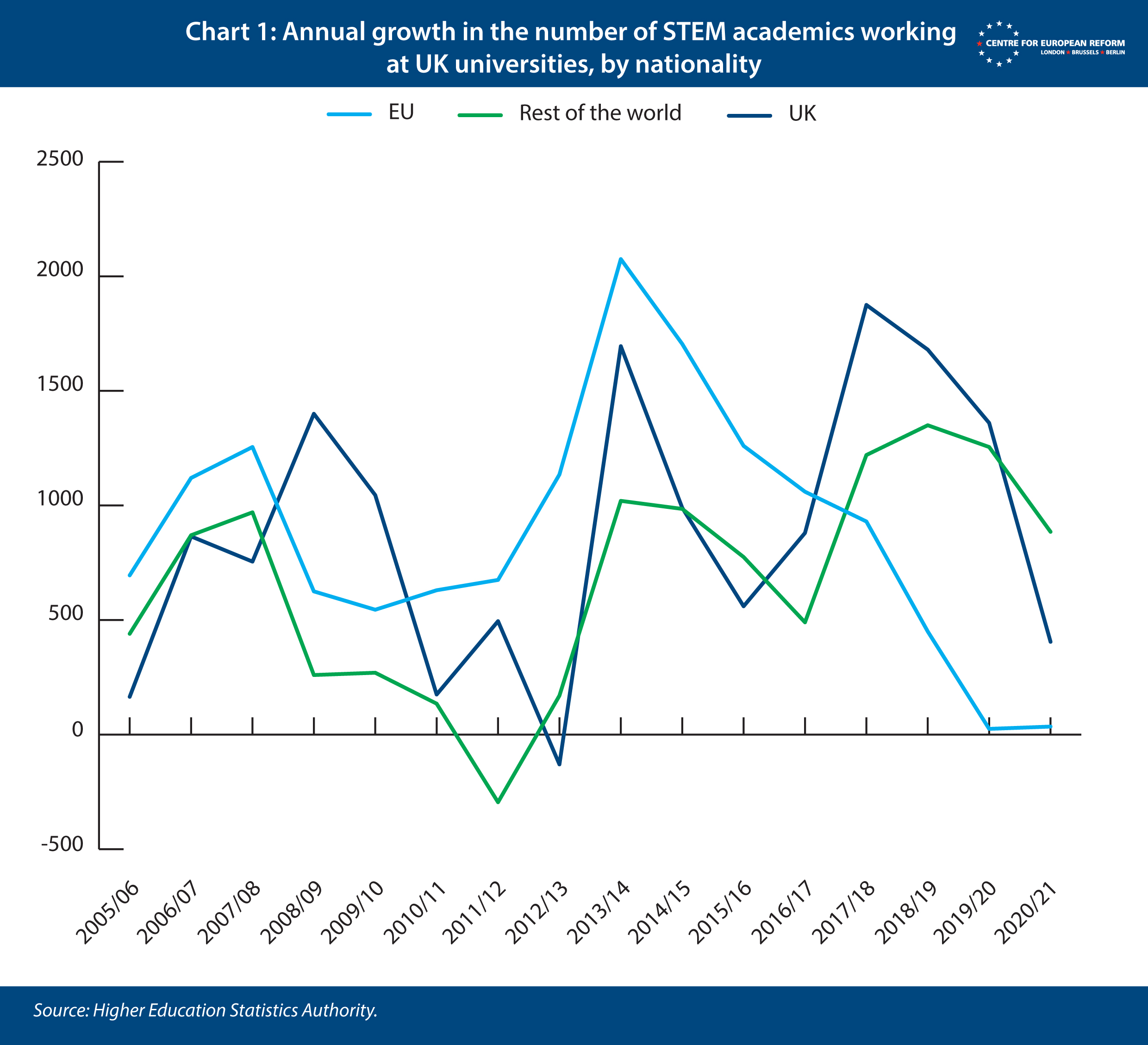
Even though the inflow of scientists from the rest of the world offset some of the collapse in EU researchers moving to the UK, it is reasonable to think Brexit has reduced the quality of science in Britain. Universities in EU member-states make up more than 100 of the top 500 universities in the world, as ranked by Times Higher Education, and it is now harder to poach their talent.4 Fewer European scientists are willing to move to the UK, in part because of the risks to funding, and it costs more for British universities to employ them – so the British labour market for scientists will inevitably have become more closed as a result of Brexit. Before the UK ended freedom of movement, universities could employ EU scientists as cheaply as British scientists. Since then, doctoral students’ fees have increased, universities have been required to pay charges for visas, and university-sponsored EU migrants have been required to pay the ‘healthcare surcharge’, an extra tax on immigrants.
How much money did the UK receive from Horizon when it was an EU member?
Apart from losing out on recruitment, the loss of Horizon membership would hurt British science financially. Horizon is a significant part of the UK’s overall science budget. UK institutions currently receive about £6 billion annually in science funding; UK researchers received about £1 billion annually over the last Horizon programme.5
On any measure, the UK has been one of the most successful participating member-states in EU research programmes in the past. As Chart 2 shows, under the 2014-20 Horizon programme, the UK received the second-highest amount of funding of any EU member-state: €7.9 billion or 12 per cent of the total available. Only Germany obtained more – 15 per cent – but it has a larger population and pays substantially more into the EU budget. The UK received proportionally more funding than it put in, unlike Germany, France and Italy, although Spain, the Netherlands and several other countries were also net beneficiaries.
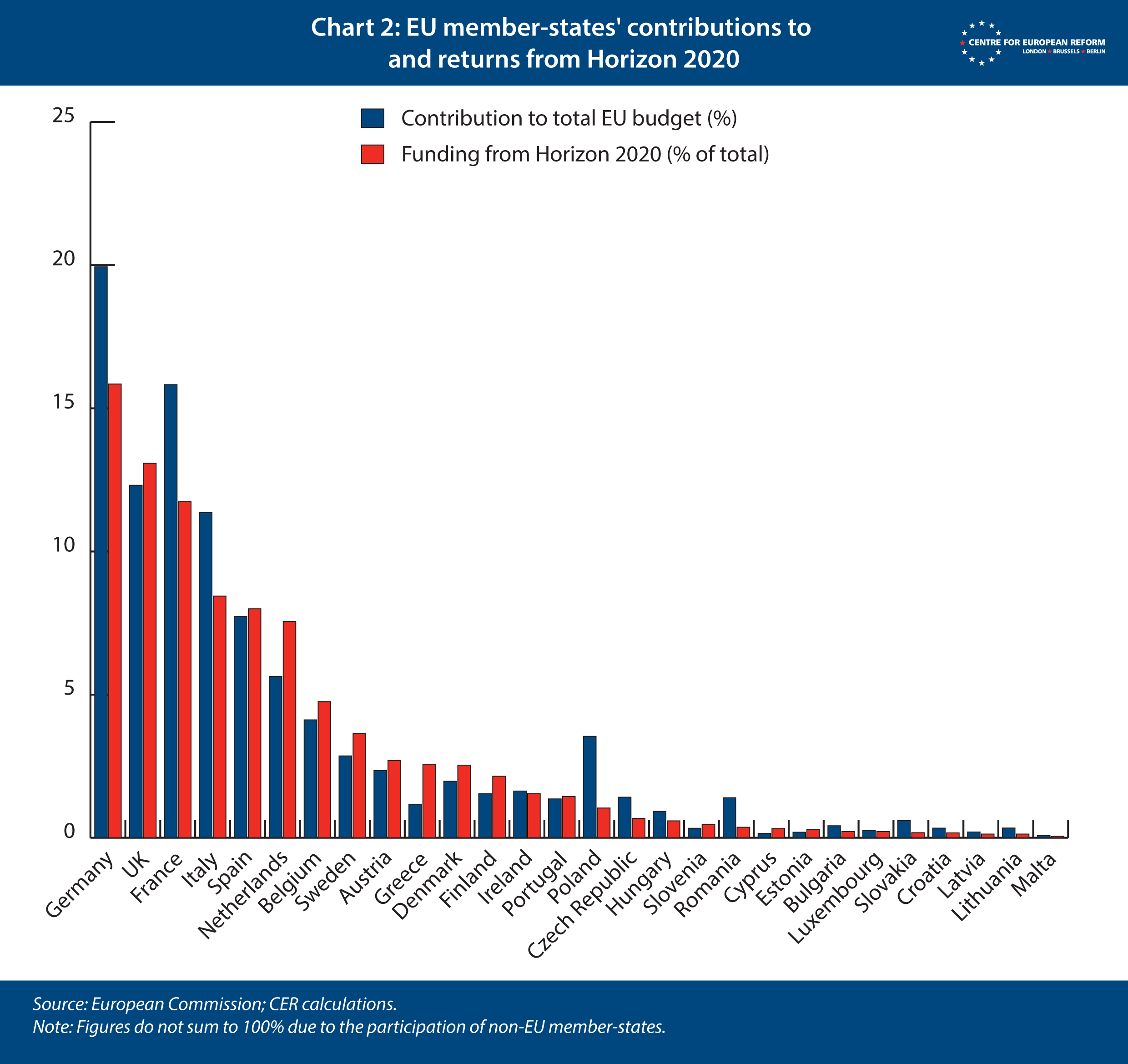
If the UK had stayed in the EU, it would have participated in the new Horizon Europe fund as a full member. Assuming the UK would be equally successful in Horizon Europe as it was in the Horizon 2020 program, it would have again obtained 12.1 per cent of total funding – worth approximately €11.6 billion.
The UK’s potential gains from Horizon Europe as an associate member
If the EU and UK had promptly agreed that the UK could participate in Horizon as an associate member, the UK’s situation would be worse in several respects than if it were a full member.
In principle, associate membership entails the same participation rights in Horizon that EU member states enjoy, including the right to both participate in and lead research projects. However, in reality there are various conditions that would limit the UK’s ability to participate to the same extent as previously:
- Associate members may be excluded from certain work programmes or topics.6 For example, the EU has previously considered excluding associate members from quantum computing and space projects to protect the EU’s strategic interests.7
- The UK is not eligible for grants or investment from the European Innovation Council Fund. This program will support small and medium-sized enterprises (SMEs) and start-ups developing disruptive innovations that are too risky for private investors. The fund is expected to invest up to €3.5 billion over the course of Horizon Europe. The UK would have been well placed to benefit from this fund, given its very high proportion of European start-ups. In 2021, the UK was home to approximately 38 per cent of the combined value of all European unicorns (start-ups with a value over €1 billion) – a startling figure even if it might be a bit skewed due to frothy start-up valuations in 2021.8
Moreover, the financial arrangements for the UK’s associate membership, as set out in the TCA, are less attractive than those the UK enjoyed as a full member. If its associate membership is settled, the UK will pay both an ‘operational contribution’ and a ‘participation fee’.9 The operational contribution would be broadly set to ensure the UK contributed the same amount as EU member-states, as a percentage of GDP, disregarding the UK’s previous rebate it enjoyed as an EU member-state.10 This implies a contribution of approximately €14.3 billion, or just over €2 billion for each of the seven years of the programme. The ‘participation fee’ would start at 0.5 per cent of the operational contribution in 2021 (presumably that money will be due if the UK joins the programme). The fee will then increase by 0.5 per cent a year until it hits 3 per cent in 2026, and then be set at 4 per cent in 2027.11 These fees would total nearly €300 million over the 2021-27 Horizon programme (ignoring any changes in GDP), creating a total cost of at least €14.6 billion.12 Calculations are set out in Table 1.
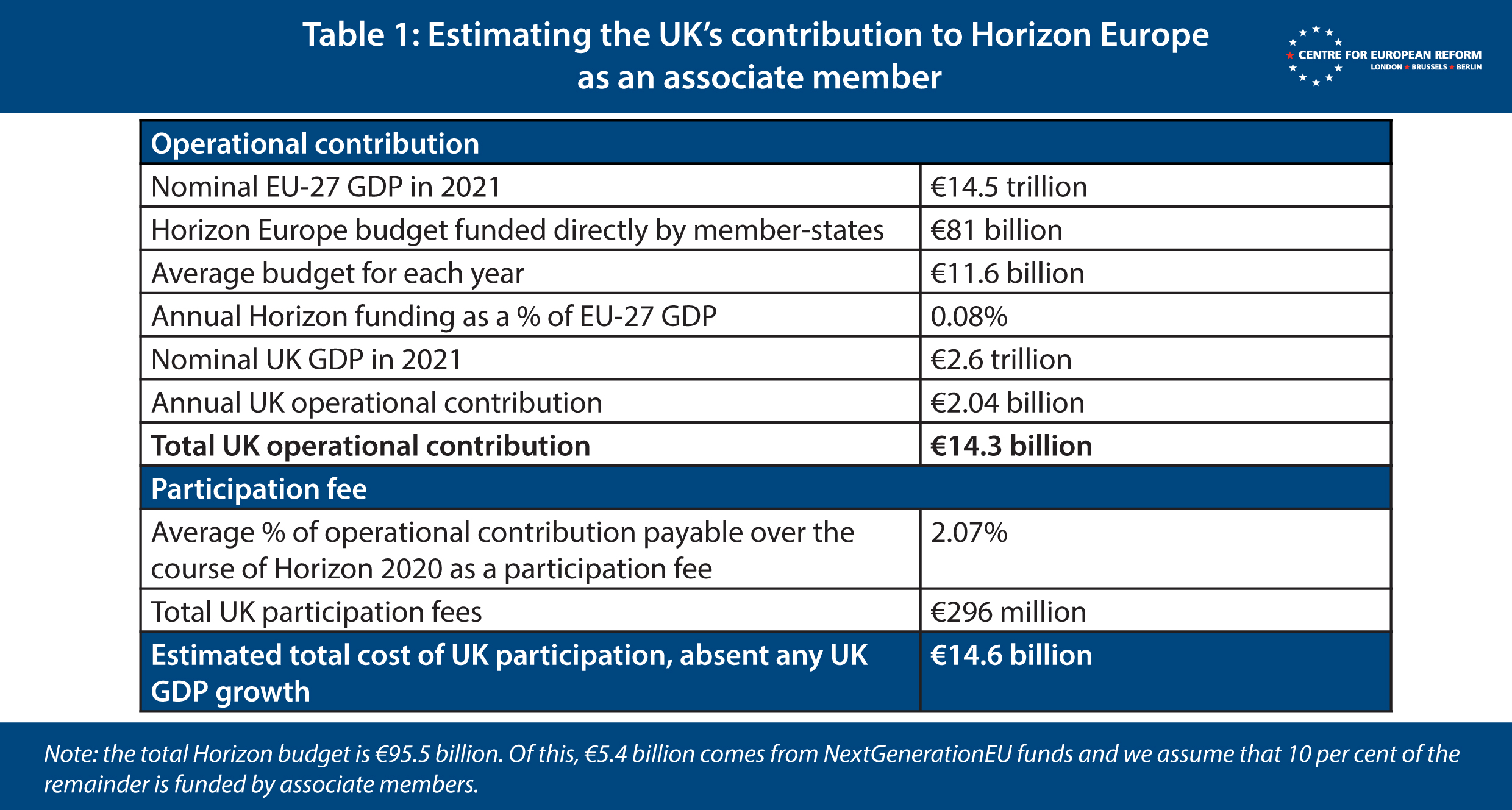
As a full member, Britain probably would have been a net recipient from Horizon, but as an associate member, it probably would be a net contributor: according to these calculations, if it joins Horizon Europe it will put in over 25 per cent more than it gets back (a figure which might be mitigated through the ‘adjustment’ mechanism described below). However, it is unlikely that the UK would repeat its performance over Horizon 2020, even if associate membership were secured tomorrow.
The UK’s share of Horizon 2020 funding dropped significantly from 2016 after the Brexit referendum as a result of uncertainty about the UK’s future participation. For example, the UK secured 15.8 per cent of grants in 2015, but only 11.3 per cent of grants in 2018.13 Preliminary data from Horizon 2020 indicates UK performance has, unsurprisingly, continued to fall.
For example, UK researchers have already dropped from the 2nd most frequent participants in Horizon 2020 projects to the 7th most frequent in Horizon Europe, based on early project calls.14 Looking at all EU funding, UK science departments would be £166 million better off in the 2020/21 academic year if EU funding had continued on its 2004-2016 trend (see Chart 3 below), a loss that represents 2.5 per cent of total funding for academic science.
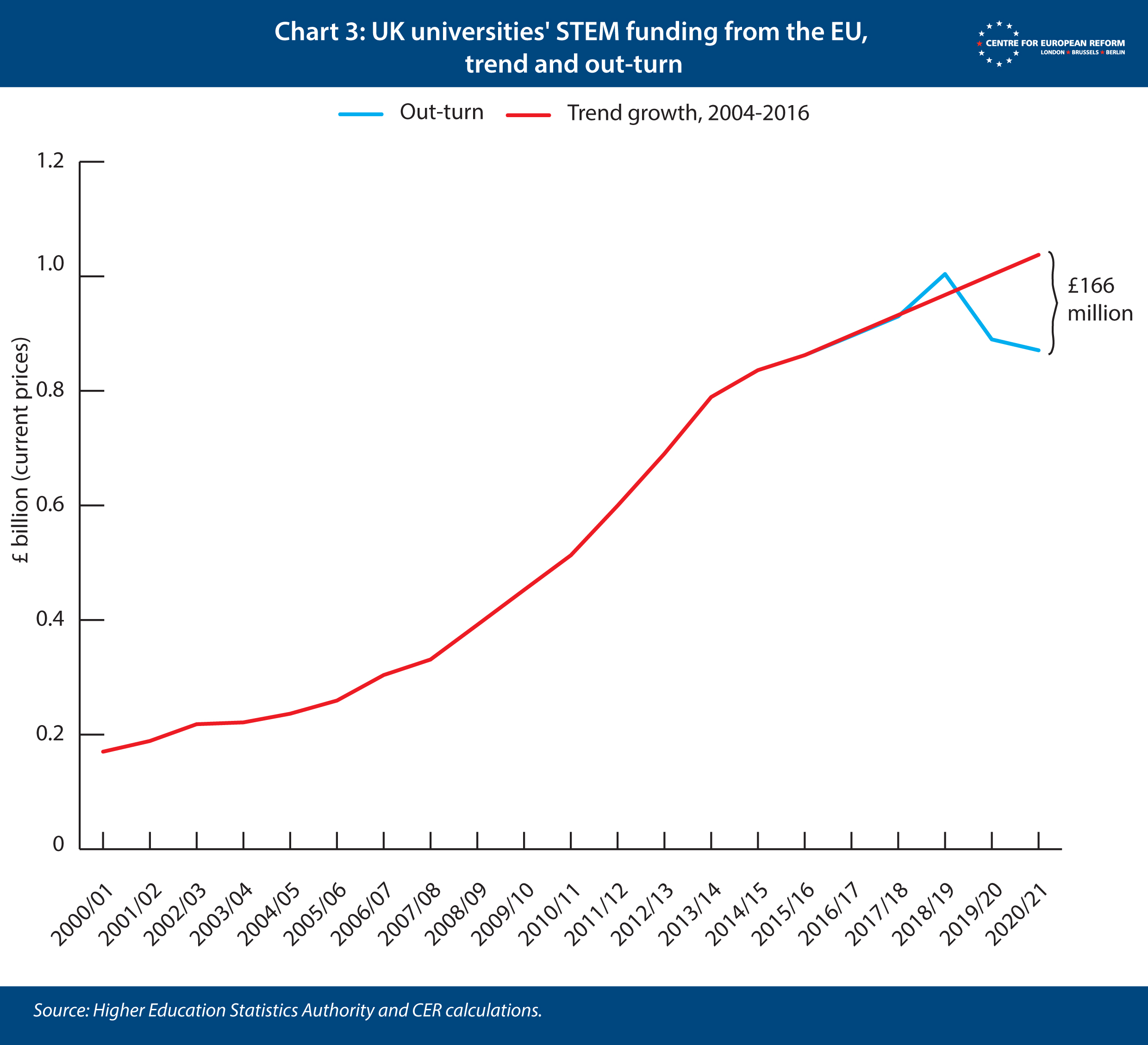
Under the UK’s associate membership, any losses the UK suffers overall may be mitigated through an ‘adjustment’ mechanism. For example, the UK is entitled to seek a review if its contributions exceed its awarded funding by more than 12 per cent.15 As our above estimates show, that would be likely if Britain joined the programme. However, even if the UK were allowed to cut payments, the UK would still shift from being a sizeable net beneficiary to a net contributor.
How would the UK government make up for the loss of Horizon Europe membership?
If the UK cannot obtain associate membership, UK researchers would not be entirely excluded from Horizon. Like other third-country researchers, UK researchers will be able to participate in many projects as long as they do not lead them and (other than in exceptional cases) they bring their own funding. Given the continuing uncertainty about the UK’s participation in Horizon Europe, the government provided a “Horizon Europe guarantee” in November 2021. Under the guarantee, the government will replace funding for researchers who had won Horizon money by the end of 2022. The government has said that this would be “funded from the budget we set aside for our association”.16 Since Britain would probably move to being a net contributor to Horizon, on a purely financial basis the UK going it alone may appear attractive.
Horizon Europe has advantages which will be impossible for the UK to replicate.
But it will still prevent UK researchers from leading many projects. The EU is not allowing UK researchers to lead joint projects funded under Horizon as long as it is unclear whether the UK will obtain associate membership. Where successful UK applicants are leading projects, they are already being asked by the EU to hand over leadership of the project to a researcher in a participating member-state, if they want to take up the grant. And, rather obviously, the UK’s unilateral commitments cannot preserve all links to Horizon Europe projects, some of which may exclude third-country researchers.
All this has prompted UK-based researchers to consider moving to the EU and contemplate alternative funding options, and has made EU researchers be less willing to partner with their peers in the UK.
Furthermore, the UK’s eventual ‘Plan B’ if Horizon Europe associate membership is not secured is unlikely to deliver the same benefits as Horizon associate membership, even if it delivers UK scientists more funds in total. Currently, the UK’s Plan B largely focuses on outlining a few transitional measures, rather than a fully-fledged set of replacement institutions and international partnerships as an alternative to Horizon. It therefore tries to protect projects and institutions which probably would have received Horizon funding but does not provide enduring certainty for researchers.
Horizon Europe has advantages which will be impossible for the UK to replicate. These include its economies of scale, which lead to overall administration costs being proportionately much lower than for most national programs; and an alignment of many regulations across most of its partners, which in certain areas (such as animal welfare standards) assists greatly in cross-border research collaboration. While the UK government has promised that Plan B will have less bureaucracy, this is not easily achieved in practice: there are already concerns that the government has too many overlapping policy strategies and too many different research governance institutions, which lead to a confusing environment for research and innovation.17
Levels of competition would be weaker, too: under Plan B, UK researchers would only be competing among themselves for funding, and not among a broader pool of European researchers. Horizon funding is known to be highly competitive and prestigious. A British alternative would mean less competition for research funds, especially in highly specialised areas of science. Over time, weaker competitive pressures will lower the quality of UK research.
Under Plan B, the government will set out plans for universities to build new research partnerships to replace those lost with the EU. UK universities have had many years to develop close partnerships with universities across the EU. This leads to efficiencies like co-ordinating investment in equipment and infrastructure to avoid duplication, and developing complementary expertise and resources. Furthermore, in areas where the UK has world-leading expertise, the number of viable research partners elsewhere in the world will be very small. Consequently, it is no simple task for UK researchers to suddenly realign their research collaborations with a new set of countries and institutions. Europe as a whole is very research-intensive, generating a third of the world’s scientific publications despite hosting only 7 per cent of the global population. The UK has taken a useful step by signing a science co-operation agreement with Switzerland, with which it has strong research connections because both were part of past Horizon programmes.18 However, in general, it will be hard to replace partnerships with links to more distant universities in North America and the Pacific.
Switzerland provides a case study in the effects of being excluded from Horizon membership 2020. In 2014, the Swiss voted in a referendum to limit freedom of movement with the EU. Like the UK, Switzerland had been a net recipient of Horizon 2020 funds up to that point, when it was excluded from the programme. Despite the Swiss government taking a similar approach to the UK government by promising “bridge funding”, Swiss researchers’ leadership of Horizon 2020 projects immediately declined; Swiss researchers had led 3.9 per cent of Horizon projects before the vote, but that declined to 0.3 per cent of projects afterwards.19 In June 2021, Switzerland was also left off the provisional list of third countries eligible for Horizon Europe funding, with the EU pressuring the Swiss to agree to new governance arrangements for the Swiss-EU relationship. The Swiss government again put in place replacement funding. However, the umbrella organisation of Swiss universities highlighted that this did not stop the damage to Swiss science: “Projects can no longer be realised as planned, Swiss researchers are losing project leaders, and projects and researchers are relocating to EU countries.”20
Finally, the British government has been presenting participation in Horizon Europe and its Plan B as an “either/or” proposition. But participation in Horizon Europe would not have prevented the UK from developing new research partnerships in other parts of the world. There is no trade-off: losing Horizon membership is an unequivocal loss.
Brexit and science and technology in the private sector
The challenges to basic research funding and university recruitment will largely affect academic and basic research in the UK. This is an area where the UK has relative strengths. A relatively high proportion of UK R&D funding goes into universities, of which many in Britain are world-class. As Chart 4 shows, Britain performs well against similarly sized peers producing highly cited research.21
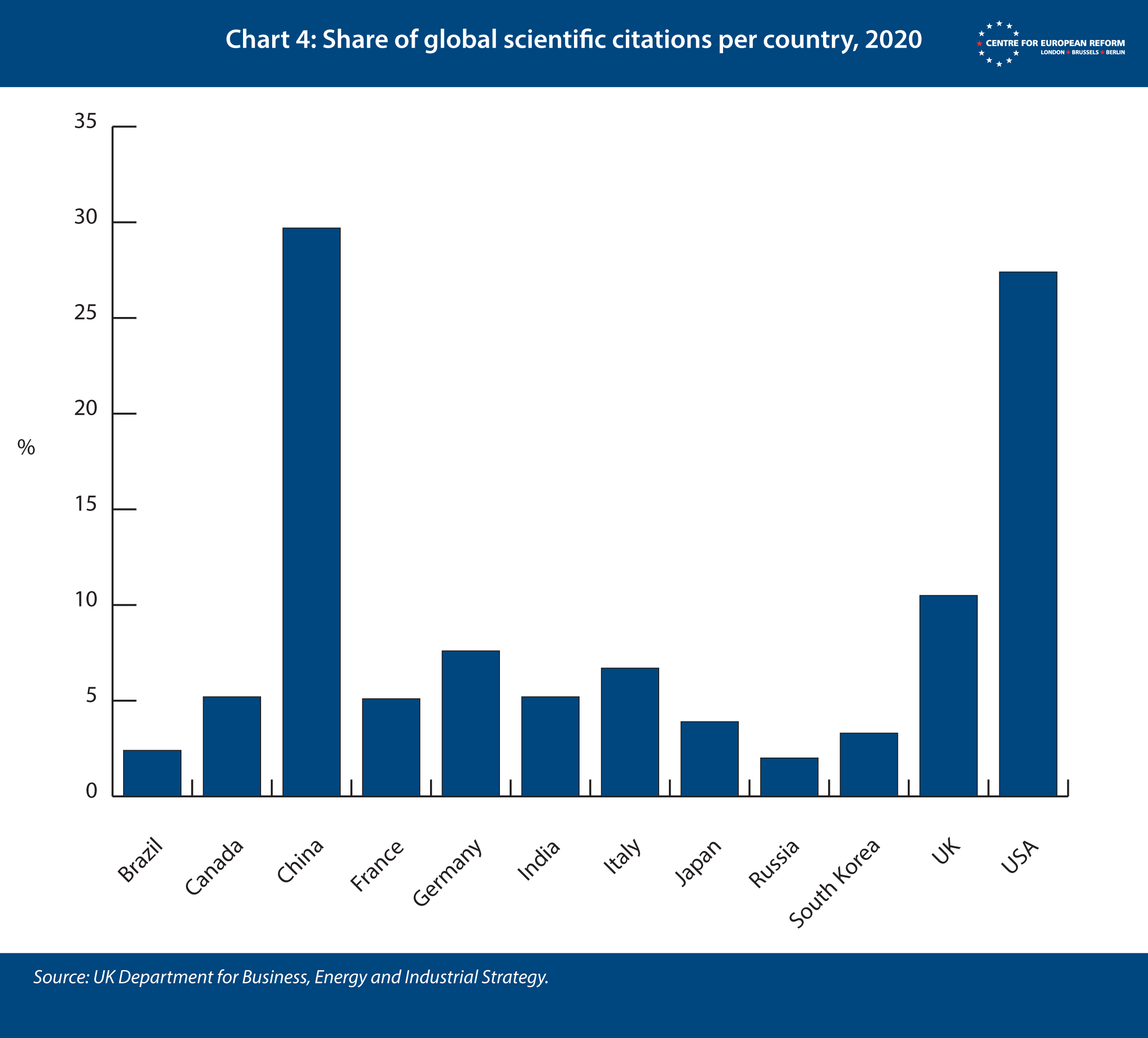
However, Britain’s failure to translate success in academic science into innovation and productivity growth in the private sector has been well documented, especially outside the most prosperous areas of the country.22 Academic science is important to society because advancing knowledge is an end in itself. But science is also an important foundation for economic progress. Good universities recruit good international students, who might stay in Britain and contribute to its economy. And new potential drugs, battery technologies and agricultural techniques that are developed in British university labs can be commercialised, adopted by the private sector, and exported to the rest of the world.
However, the UK’s low private-sector R&D spending – nearly a third less than the OECD average – means that many of its scientific breakthroughs are developed and commercialised in other countries.23 This has been a long-term problem for Britain. But Brexit has made the problem worse, because firms will generally prefer to commercialise technologies in countries that have a larger market. The UK’s attractiveness dimmed as it left the single market, and investors fear that the UK could diverge from EU regulation in the future, adding to hurdles to trading with the EU.
Under prime minister Boris Johnson, the government set out plans to change this by boosting public R&D expenditure, improving linkages between universities and industry, and expanding the UK’s “high-growth, innovative sectors”.24 The government’s July 2020 ‘R&D Roadmap’ aimed to increase public and private R&D spending from 1.7 per cent of GDP in 2019 to 2.4 per cent of GDP by 2027 and to 3 per cent in the long term. As part of these plans, the government announced that the country’s R&D budget would be the largest ever, allocating £40 billion to deliver the UK’s innovation strategy. The government has also committed to increase public R&D expenditure to £20 billion a year by 2024-25.
However, these targets are less ambitious than they appear and are unlikely to address the UK’s R&D problem.
First, the 2.4 per cent target was set to match the OECD average in 2017 – but since then, the average has risen (see Chart 5). Many countries are more ambitious: in 2020, Germany’s R&D expenditure reached 3.2 per cent of GDP, yet it aims to increase this figure to 3.5 per cent by 2025.25
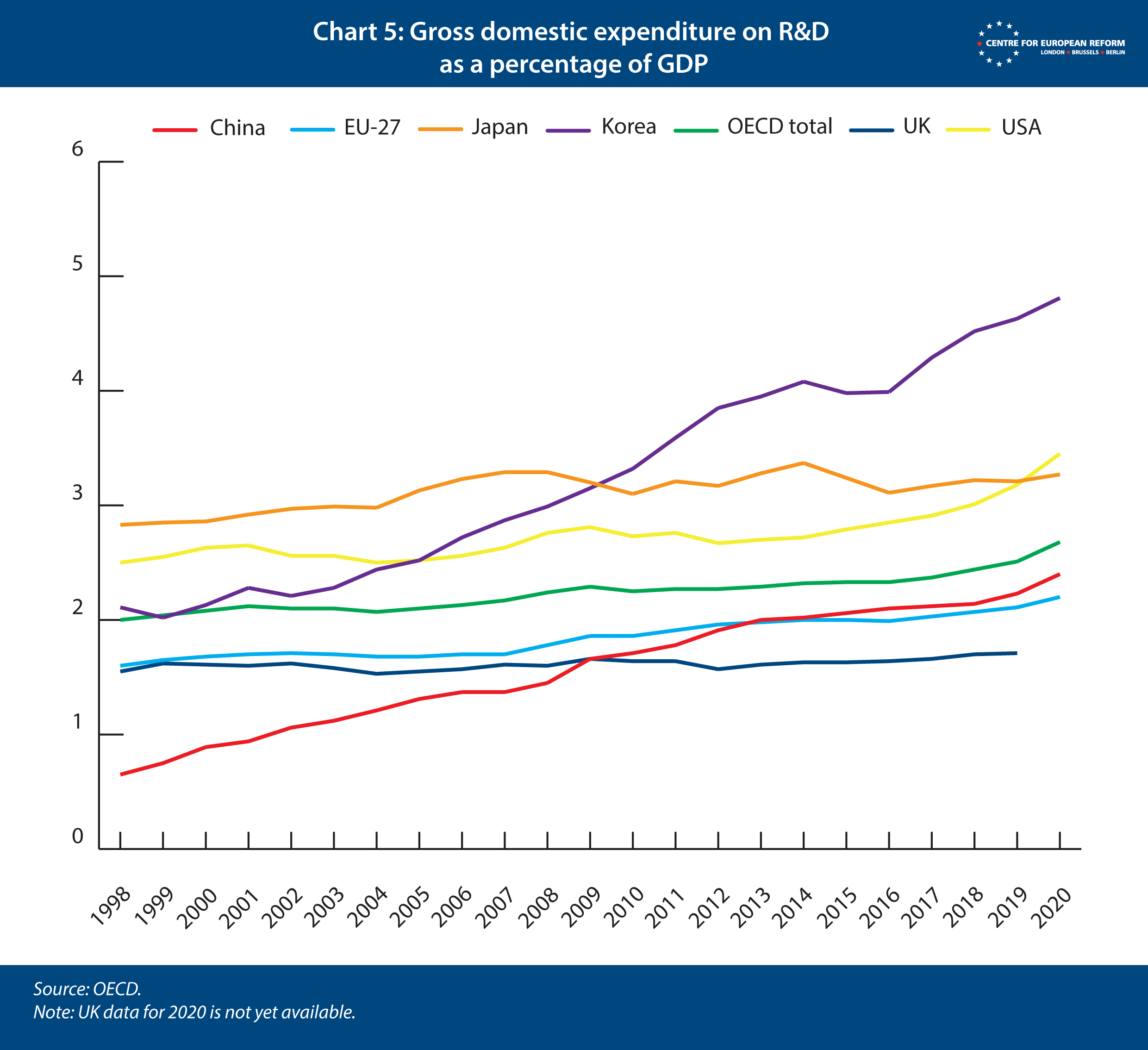
Second, the UK government also needs to foster better links between universities and industry, but does not seem prepared to devote sufficient funding to that goal. For example, the UK’s Catapult centres were set up in 2011 and aim to speed the application of academic research, providing expertise and facilities for firms to scale up and commercialise new technologies. However, they suffer from numerous weaknesses. They have been subjected to repeated ad hoc reviews (in 2014, 2017 and 2020-21), which has generated doubt about their future. Their scale remains modest: for example, between 2011 and 2021 they directed about £2.5 billion of private and public sector investment, or about £250 million per year, and they are limited to specific areas of technology.26 The government has just announced their funding will increase by 35 per cent. However, that is still modest. Germany’s equivalent, the Fraunhofer-Gesellschaft, had a turnover of €2.9 billion in 2021 alone and its institutes cover a far broader range of economic sectors.27 They are evaluated on a formal and consistent basis every five years, rather than on an ad hoc basis, and have developed much deeper and more enduring relationships with universities than Catapult centres typically have. The Fraunhofer system has helped increase private sector R&D spending, which in Germany has reached two-thirds of overall R&D expenditure, compared to just over half in the UK.28
Two-thirds of R&D spending in Germany comes from the private sector, compared to just over half in the UK.
Third, public R&D spending will only unlock private sector spending if the broader environment is conducive to such investment. That means being able to attract and recruit skilled entrepreneurs and technologists, having a stable policy environment that supports long-term investment, and access to patient investors who are willing to wait for returns to arrive. In some areas, such as the life sciences and fintech, the UK has been able to nurture a relatively strong pipeline of innovation among start-ups, and the UK has seen significant venture capital and incoming foreign investment. However, London’s stock markets are characterised by low-innovation, ‘old economy’ firms like banks.29 Many smaller firms which do invest in commercialising innovations end up being purchased by foreign buyers or listing overseas.30
Fourth, when it comes to adoption of already-commercialised technologies, the UK’s very weak productivity growth since the mid-2000s is in part down to companies failing to invest in the latest technologies and skills. The UK enjoys relatively high levels of infrastructure that supports technological development – like widely accessible high-speed broadband – but it performs poorly in integrating new technologies into businesses, redesigning business processes, and investing in next-generation technologies.31
After the vote to leave in 2016, overall business investment flatlined, before falling markedly during the pandemic. And more STEM-intensive sectors of the economy have struggled as much as other sectors – Brexit has curbed investment in communication and information technology, finance (which employs many IT specialists, programmers and statisticians), and pharmaceuticals. When he was prime minister, Johnson promised that Britain would become “a high-wage, high-skill economy”, and he and his strategist Dominic Cummings had hoped that fostering investment in science and technology might help to establish a new economic model.32 But Brexit has proved to be a broad-based shock to the British economy, affecting investment across economic sectors, and so far, it has undermined that vision.
Chart 6 shows business investment in ‘low-STEM’ sectors, like retail and hospitality, and ‘high-STEM’ sectors, in which more than 10 per cent of employees have a STEM degree, like information and communication technology or manufacturing, which is more directly affected by the trade barriers with the EU. Investment growth in all three sectors was broadly similar before the referendum and has been hit by the vote to leave the EU fairly equally.
The weakness of investment across sectors reflects how the single market differs from a free trade agreement (FTA). The latter largely reduces tariff barriers to trade, which tends to improve investment in the types of manufacturing and agriculture in which a country has comparative advantage. Participation in the EU single market, by contrast, also curbed non-tariff barriers to trade, such as differing regulations, state aid, and preferential employment of citizens, which raised trade and investment in more highly-skilled services, such as ICT, finance, professional and scientific services.33 British firms that do not export but serve companies that do are also hit by higher trade barriers: car factories need professional cleaners.34 That explains why Brexit has curbed investment in science and technology-heavy sectors of the economy, as well as manufacturing and less-skilled sectors.

Will Britain’s new immigration system deliver the skills it needs?
The end of free movement has made it harder for Britain to attract highly skilled workers. So far at least, British universities have managed to replace academic scientists from the EU with British citizens and those from the rest of the world. British companies have found it harder to perform the same switch after the end of free movement, however. Businesses will not adopt new technology if they do not have access to skilled workers who can deploy and use it. Most workers in the British labour market are educated and trained in the UK, but foreign workers have filled about half of the additional jobs created in British companies each year since 2014. The analysis below suggests that the UK would have to liberalise its new visa regime further, if it wanted to attract as many new skilled foreign workers each year as it did before the end of free movement.
The UK’s new immigration regime came into force in January 2021: thereafter, almost all workers seeking to move to the UK from the EU and from the rest of the world needed a job offer to get a visa. The new system is more liberal than many people expected. The old system’s salary thresholds have been reduced, and there is no longer a ‘labour market test’ that sponsoring employers must undertake to show that the job could not be done by someone already in the UK labour force. For sponsors in comparatively high-skilled, high-wage jobs, there are few prohibitions on bringing in a new hire from overseas. Jonathan Portes, an academic who specialises in UK immigration policy, estimates that “more than half of all jobs in the British labour market are open to anyone from anywhere in the world”.35
There are still many constraints, however. Employers must pay up to £1,476 to become licensed to sponsor foreign workers, plus up to £199 to assign a certificate of sponsorship to a particular foreign worker, plus an ‘immigration skills charge’ of up to £5,000 (for a large sponsoring organisation seeking to sponsor a worker for five years, although many science and education roles are exempt from this skills charge). The application fee for a typical ‘skilled worker’ visa costs between £625 and £1,423, depending on whether the visa is for less or more than three years. For certain jobs, some of these fees are reduced: for example, visas on the ‘shortage occupation’ list cost between £500 and £900. Most visa applicants must also show they have more than £1,270 in their bank account.36 The government applies a tax on all visa holders at the rate of £624 per year: it is called the ‘healthcare surcharge’, which is misleading since immigrant workers already pay more in taxes than they take out in public services and welfare.37 In addition, employers and employees will often want to seek assistance from a specialist immigration adviser, given the complexity of the process, the costs and delays associated with making mistakes, and the continuing compliance obligations of sponsoring organisations. These specialist fees can run to many thousands of pounds.
While the government has pursued a comparatively liberal immigration regime, fewer EU immigrants, high levels of sickness and workers retiring early have all contributed to a very tight labour market.38 The unemployment rate is at 3.5 per cent, a historic low.
Labour shortages are worse in low-skilled services sectors. But what about ‘high-STEM’ sectors that employ more science graduates?
Will the new visa regime provide enough workers to fill the skills needs in these sectors? In Chart 7, the blue bars show how many visas were issued between the third quarter of 2021 and the second quarter of 2022. We then show estimates of how many more visas the Home Office would have to issue to match the openness of the prior regime, with free movement for Europeans and visas for everyone else (see the box for details). That is represented by the red bars on the chart.
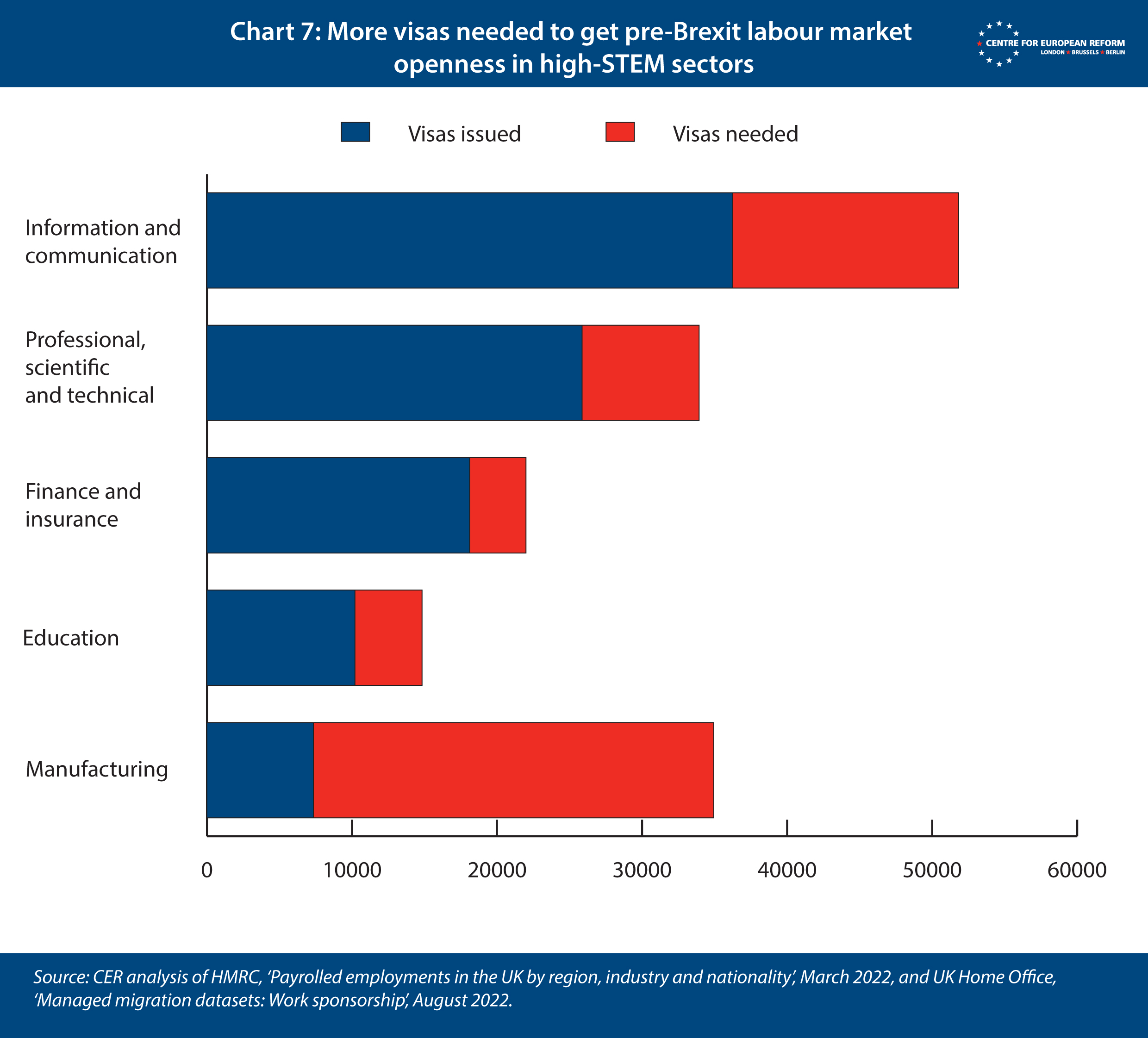
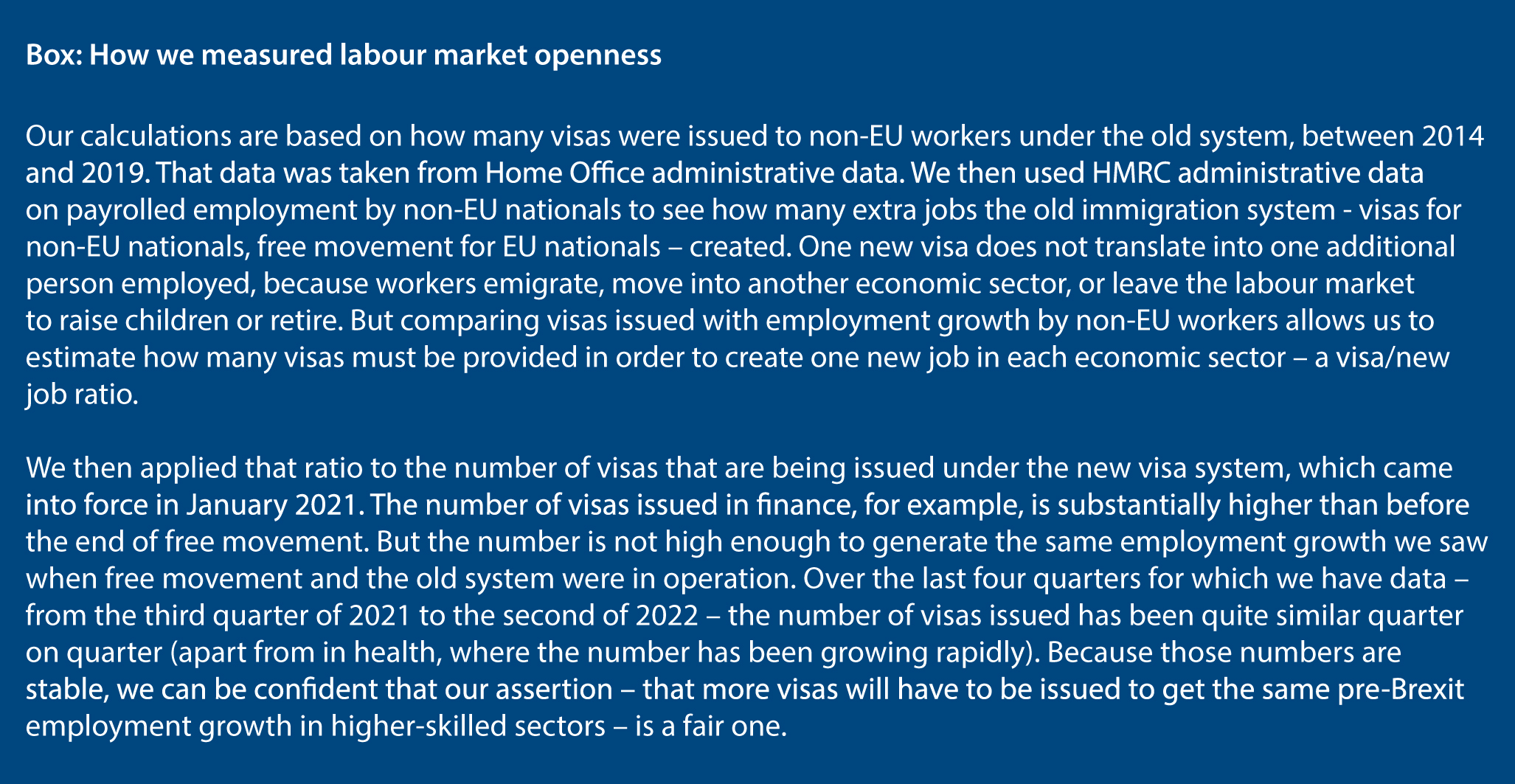
The chart shows that the new system is likely to lead to fewer new foreign workers across economic sectors which employ the most science graduates. The biggest tightening of labour supply occurs in manufacturing. Despite employing many STEM graduates, this sector also employs many low-skilled workers for its assembly lines. New technology cannot raise output without workers to use it, and manufacturing now has a big labour supply problem. High-STEM services sectors – ICT, finance, professional, scientific and technical services, and education – have received many more visas from the Home Office than before Brexit, but they may need even more to achieve the same openness they enjoyed under the old immigration system.
All this implies that the government may have to make immigration easier if the UK is to see as much job growth in more highly skilled sectors of the economy as it had before Brexit. And, because manufacturing is struggling with a big labour supply shock, it may be necessary to give more visas to less-skilled foreigners in that sector.
Recommendations for UK science and technology policy after Brexit
The UK government has a significant challenge ahead to protect its position in science and innovation and address the UK’s weaknesses in this area. This task will need to encompass the whole value-chain of innovation – from protecting basic research, through to improving the domestic commercialisation and scaling up of technology, and encouraging more investment in technological adoption by UK businesses. At each stage, the UK also needs the right levels of skilled labour.
Supporting basic research
In terms of basic research, the UK’s exclusion from Horizon Europe membership would be unequivocally bad for the UK. With political will, the government should be able to fund the modest gap between the amount the UK would pay into Horizon and amounts UK researchers could expect to receive. In fact, our analysis shows that on a purely financial basis, the UK might be better off going it alone than pursuing associate membership. But only associate membership would provide certainty for UK and EU researchers about future funding and collaborations. It is not just a question of money, either – Horizon’s prestige, its competitiveness and its economies of scale will all be hard for the UK to replicate. More importantly, it would take years for UK researchers to reorient their research programmes and build new global partnerships; and to develop credible replacements for EU institutions and funds.
Negotiating a mutually agreed solution to the UK’s concerns about the Northern Ireland Protocol would unlock Horizon (associate) membership, and lift the threat of a trade war, which would help raise investment across the economy.39 On the one hand, there are some positive signs that the Conservatives may be prepared to drop some of their red lines in order to reach a pragmatic outcome with the EU.40 On the other, the prime minister has also said he is committed to the Northern Ireland Protocol bill, which the EU finds incendiary because it would give ministers the power to breach the Northern Ireland Protocol, part of the legally-binding withdrawal agreement.
Commercialisation
The UK must also address its long-running failure to commercialise basic research. This implies not just increasing funding for academic institutions, but spending far more on increasing links between universities and industry. The scale of Britain’s Catapult programme is modest. Such centres tend to have more impact after they have had time to become established. They require certainty about their future, a period to develop and execute a strategy before their performance is reviewed, broader scope and significantly more funding.41 Smaller firms also need access to capital, so that they can take high-risk bets without leaving the UK. The government has agreed to take forward the recommendations in Lord Hill’s review of the UK listing rules, to help smaller firms more easily raise capital so they remain in the UK.42 The number of new listings in UK stock exchanges has fallen precipitously in recent years, and many high-tech UK-based start-ups eventually choose to list overseas.
The UK’s chaotic political environment post-Brexit has likely been a drag on investment.
Improving R&D and business investment
To encourage investment levels like those of the UK’s peers, R&D as a proportion of GDP needs to be significantly increased. Increases in public R&D, such as those the government has just announced, may be a good starting point, and if the expenditure is well-designed, it may create opportunities to unlock greater private R&D. The government could have been tempted to reduce public R&D given the deteriorating economic situation, to help reduce pressure on the government to make cuts elsewhere. But Sunak rightly concluded this would be to the UK’s detriment over the long run, and would be especially damaging for businesses and investors looking for certainty, after Johnson only recently committed to greater public R&D spending.
The government has also sensibly reviewed R&D tax incentives to ensure their international competitiveness.In many cases these are already generous: for example, SMEs can receive up to a 230 per cent tax deduction on R&D expenditure.43 However, there is good evidence that these incentives are not working as well as they should at unlocking private R&D. Sunak has cited the fact that on average in the OECD, R&D spending is thirteen times the amount of R&D tax relief. In the UK, it is only three times. This suggests the UK tax system is still not giving firms strong enough incentives to invest in R&D.44 The government has rebalanced the rate relief rates so larger companies have more incentives to invest in innovation. That is sensible given the poor rates of innovation among established UK businesses. The government should also consider whether the scope of tax incentives need to be widened: for example, they do not cover data-driven research, even though the UK’s many service-oriented businesses will largely be innovating by finding ways to use data more effectively and efficiently.”
The UK’s chaotic political environment post-Brexit has also likely been a drag on investment. Since many significant investments require large amounts of capital and time to achieve results, finance for those investments will often require a reasonable level of long-term certainty about the broader political and regulatory landscape. The House of Lords Science and Technology Committee recently accused the UK of lacking “an overarching plan for the strategic development of UK science and technology”,45 with few measurable outcomes having been articulated, and little guidance about future policy direction. The UK government’s approach has been too focused on identifying “Brexit dividends” and making headline-grabbing announcements, rather than listening to businesses, setting out multi-year strategies, and sticking to them. As examples of the lack of certainty:
- The UK has had a significant turnover of science ministers in recent years and, for a period this year, nobody held that position. This has contributed to the perception that the UK government lacks a coherent and stable science and innovation policy.
- In recent years, the number of planned or published government strategies covering areas of innovation has been excessive. Publications under Johnson’s government included the National Data Strategy, Innovation Strategy, Artificial Intelligence Strategy, a 5G Diversification Strategy, a Digital Inclusion Strategy, Online Media Literacy Strategy, Energy Digitalisation Strategy, National Cyber and Digital Strategies. A Quantum Strategy, Semiconductor Strategy, Wireless Infrastructure Strategy and International Technology Strategy are in development. The proliferation of policy documents makes it difficult for businesses to easily understand the government’s priorities, provides little assurance that there is a long-term approach, and has created doubt as to whether the government’s many policy ideas form a coherent and consistent whole.
- The pace of innovation-related government reviews has also increased. The Grant Review of UK Research and Innovation was published in July 2022; the Tickell Review into the UK’s research funding bureaucracy was published the same month; and a review into the UK’s Research Excellence Framework is also underway. In its Innovation Strategy, the government also announced a new overarching review “looking across the landscape of UK organisations undertaking all forms of research, development and innovation.” The problem with frequent reviews is that government is unlikely to have the capacity to properly consider and implement the recommendations, and it distracts research institutions from focussing on delivery. This is particularly important given that these reviews have taken place while many of the UK’s innovation bodies – such as UK Research, the National Science and Technology Council, and the Office for Science and Technology Strategy – are still relatively new.
- There are many examples where the government has announced specific policy changes which are then not implemented for many years. In the digital sector, this includes long-mooted changes to competition policy. A government-commissioned expert report in 2019 recommended a new competition law regime to improve competition in digital markets, which would help tech businesses starting up and scaling up in the UK. Yet the government, despite periodically reaffirming its support for the reforms, has failed to even publish a draft bill to enact them (although it has just recommitted to tabling the bill). This is likely not only to delay investment by firms waiting for the new competition rules, but also to create questions about the credibility of the government’s policy commitments. There are similar examples, such as the continued uncertainty about the shape of the UK’s data protection reforms. If the EU considers those reforms to materially reduce the UK’s data protection standards, UK firms will face significant new costs and barriers to trade with the EU. The government is still redrafting its proposals, so investors cannot judge how likely this outcome will be. Investment in data-heavy businesses will probably be curtailed until the uncertainty is lifted.
In several cases, the government appears willing to undermine the independence of sectoral regulators. For example, it is reportedly considering giving ministers the power to override decisions of the Financial Conduct Authority and similar bodies, and its proposed data protection reforms would require the UK’s data protection regulator to consider the government’s strategic priorities. These reforms will make regulation more politicised and less predictable.
British businesses have not been able to attract sufficient staff following the end of free movement.
At its most extreme, the UK’s regulatory instability and unpredictability is illustrated by the Retained EU Law (Revocation and Reform) Bill, which would remove all EU-derived law from the UK statute book at the end of 2023 unless ministers expressly decided to keep it. The prospect of government replacing the thousands of EU-derived laws – or even developing policies to cover each of these areas – in just over a year is fanciful. But the bill illustrates how political pressures are forcing government to impose uncertainty on businesses, which makes them reluctant to make investments that might pay off only if the policy environment is predictable over several years.
While political certainty cannot be guaranteed, the British government could focus less on chopping and changing, and more on developing and executing a coherent strategy. In comparison to the UK, countries known to be successful at commercialising R&D have tended to create and deliver stable, long-term goals. For example, Germany developed a cross-party pact between its federal government and its sub-national governments for research and innovation in 2005, which has been extended multiple times, most recently in 2019. That pact sets out an annual increase in research and development budgets of 3 per cent a year, originally until 2010 but now until 2030, providing a more secure environment for planning and investment in innovation by greatly reducing political risk. All the major UK political parties should follow the German example, and agree to multi-year targets for science and innovation funding. They could promise to raise the Catapult centres’ annual budgets to German levels, maintain that funding, and agree not to conduct unprompted reviews into their governance for a certain period, irrespective of which party or parties form the government.
Ensuring the UK has access to skills
Finally, ensuring the UK has the right skills is essential to improving the UK’s science and technology position. Brexit has made it harder for British universities to attract European scientists. For British businesses, the problem is even worse, as they have not been able to attract sufficient staff following the end of free movement.
The prime minister is reportedly planning significant reforms to the British education system, including some designed to tackle the UK’s stubborn skills shortages.46 While such initiatives have potential, they will take years to flow through to economic growth. The UK could immediately improve the situation by significantly reducing the charges associated with visas, such as sponsorship costs, the healthcare surcharge, the ‘immigration skills charge’, and application fees themselves. The data shows that this would make a significant difference to the UK’s ability to attract skilled workers. For example, the Health and Care Worker Visa was launched in August 2020 and allows certain health professionals to obtain a Skilled Worker visa without having to pay the healthcare surcharge for themselves or their partners and children. For a doctor with a partner and two children on a five-year visa, that saving is worth £10,940.47 This has helped address the scarcity of workers in the UK’s health sector, and extending it to science and technology-intensive sectors of the economy would bring in more skilled workers. There may be benefit in opening up worker visas for lower-paid and lower-skilled positions in manufacturing, too, since it is facing a big labour supply problem.
More generally, the UK’s immigration system could be drastically simplified and made more user-friendly. For a company new to sponsoring foreign workers, the process involves three steps: obtaining a sponsor licence, registering a position requiring sponsorship, and then the visa application by the preferred job applicant. Many organisations revert to using specialised immigration advisers to help navigate the process. These steps make the process of foreign hires unnecessarily slow, expensive and bureaucratic. In a recent survey, 70 per cent of employers said they found recruiting workers under the new liberalised immigration regime harder than under the previous rules.48
Prime Minister Rishi Sunak’s decision to reappoint Suella Braverman as home secretary bodes poorly for the UK’s ability to institute immigration reforms that will serve the British economy. Braverman has previously said she wants to cut net migration massively, to tens of thousands, promising in particular to “substantially reduce … the number of work visas and in particular the number of dependants on those sorts of visas”.49 The government needs to fundamentally rethink its anti-immigration approach if it wants to build a high-wage, high-skill economy.
Conclusion
Brexit has resulted in various headaches for UK scientists, entrepreneurs and those developing new technologies. The most visible is the loss of the EU’s science funding programme Horizon, but investment and labour supply problems may be even more important.
Science and technology was at the heart of the UK’s recent review of security, defence, development and foreign policy. The government recognised that maintaining UK leadership in science would give it economic, political and security advantages in the coming decade. Yet it is unlikely that the government will fulfil this ambition without substantial changes. Instead, it risks watching its rivals gain advantages and shape international norms.
Although it is impossible to resolve all the problems without rejoining the single market, we have outlined a strategy that would provide something of a salve.
2: Higher Education Statistics Authority, ‘Higher education provider data: Finance’, 2020-1. This data is expressed in current values, and includes Horizon funding.
3: Deborah Caswell, ‘Brexit threatens international scientists in the UK like me’, Financial Times, October 23rd 2018.
4: Times Higher Education, ‘World university rankings 2023’, 2022.
5: Higher Education Statistics Authority, ‘Higher education provider data: Finance’, 2020-1.
6: Limitations or conditions can be set out in particular work programmes or the call/topic text. For example, projects may be limited EU members, or only specified third countries, to safeguard the EU’s strategic assets, interests, autonomy or security.
7: Nicholas Wallace, ‘Europe loosens funding rules for non-EU quantum and space researchers’, Science, June 16th 2021.
8: Oscar Hornstein, ‘UK startups reared 38% of European unicorn value in 2021’, UKTN, March 1st 2022.
9: TCA art 714.
10: Subject to potential adjustments, for example to reflect work programmes from which UK might be excluded.
11: TCA art 733.
12: This roughly correlates to the UK’s government’s own estimate that Horizon Europe participation would cost “around £14 billion”. See Eanna Kelly, ‘UK announces €250M towards Horizon Europe participation cost following scientist revolt’”, Science Business, April 2nd 2021.
13: The Royal Society, ‘Brexit is already having a negative impact on UK Science’, 2019.
14: Universities UK, letter to European Commission Vice-President Maroš Šefčovič, May 30th 2022.
15: TCA art 716. Conversely, the EU may also make a correction if the UK receives more in grants than its operational contribution, with a threshold of 8 per cent over two successive years.
16: UK Department for Business, Energy and Industrial Strategy, ‘Policy paper: Supporting UK R&D and collaborative research beyond European programmes’, July 20th 2022.
17: Ian Sample, ‘‘Science superpower’ plan risks making UK bureaucracy superpower, says peer’, The Guardian, August 4th 2022.
18: UK Department for Business, Energy & Industrial Strategy and George Freeman MP, ‘UK signs major science co-operation agreement with Switzerland’, November 10th 2022.
19: Lise Bailat, ‘La place scientifique respire’, Le Temps, December 16th 2016.
20: Swiss Universities, ‘European programmes - Time is pressing for the universities’, May 12th 2022.
21: House of Commons Library, ‘Research and development spending’, September 2021.
22: For a survey of the UK’s innovation performance, see Henry Farmer and Madeleine Gabriel, ‘Innovation after lockdown: Using innovation to build a more balanced, resilient economy’, Nesta, June 2020.
23: OECD, Science and technology indicators database, 2021.
24: Her Majesty’s Treasury, ‘Build Back Better: Our plan for growth’, March 2021.
25: German Federal Ministry of Education and Research, R&D Policy Framework.
26: UK Department for Business, Energy and Industrial Strategy, ‘Catapult Network Review’, April 2021.
27: Fraunhofer-Gesellschaft, Annual Report 2021.
28: Cambridge Industrial Innovation Policy, ‘UK Innovation Report’, 2021.
29: Andrew Whiffin, ‘Lex in-depth: why is the UK stock market so cheap?’, Financial Times, March 6th 2022.
30: A recent example is UK chipmaker Arm, which was bought by Japanese firm Softbank. Softbank is now seeking to list the company, and is likely to do so on the Nasdaq rather than in London.
31: McKinsey Global Institute, ‘Solving the United Kingdom’s productivity puzzle in a digital age’, September 2018.
32: Boris Johnson, ‘Keynote speech – we’re getting on with the job’, Conservative Party Conference, October 6th 2021.
33: Monique Ebell and James Warren, ‘The long-term implications of leaving the EU’, National Institute for Economic and Social Research, May 2016.
34: John Springford et al, ‘The economic consequences of leaving the EU’, CER report, April 2016.
35: Jonathan Portes, ‘Immigration and the UK after Brexit’, VoxEU, June 25th 2021.
36: UK Government, ‘Skilled worker visa – how much it costs’, October 2022.
37: Migration Observatory, ‘The fiscal impact of immigration to the UK’, March 30th 2022.
38: John Springford, ‘What can we know about the cost of Brexit so far?’, CER policy brief, June 2022.
39: Hilary Benn, ‘How to fix the Northern Ireland protocol’, CER policy brief, September 2022.
40: Steve Baker and Simon Hoare, ‘As prime minister, Rishi Sunak can fix the Northern Ireland protocol’, The Times, October 23rd 2022.
41: Department for Business, Energy and Industrial Strategy, ‘Catapult network review: How the UK’s Catapults can strengthen research and development capacity’, April 2021.
42: Jonathan Hill, ‘UK Listing Review’, March 3rd 2021.
43: A tax deduction allows a SME to reduce their taxable income. SMEs are firms with less than 500 staff and a turnover of under €100 million or a balance sheet total under €86 million. Loss-making SMEs, and larger firms, may also be eligible for tax credits – effectively, a subsidy – for some R&D spending.
44: Rishi Sunak, ‘Chancellor’s opening address to London Tech Week’, June 13th 2022.
45: House of Lords Science and Technology Committee, ‘“Science and Technology superpower”: More than a slogan?’, August 4th 2022.
46: Oliver Wright and Rachel Sylvester, ‘British baccalaureate among Sunak education policy reforms’, The Times, October 26th, 2022.
47: The charge is £624 per adult per year and £470 per child under 18 per year.
48: All Party Parliamentary Group on Migration, ‘The Impact of the New Immigration Rules on Employers in the UK’, September 2021.
49: Rajeev Syal, ‘“Suella Braverman revives Tory pledge to cut net migration to ‘tens of thousands’”, The Guardian, October 4th, 2022.
Zach Meyers is a senior research fellow and John Springford is deputy director of the Centre for European Reform.
November 2022
View press release
Download full publication

